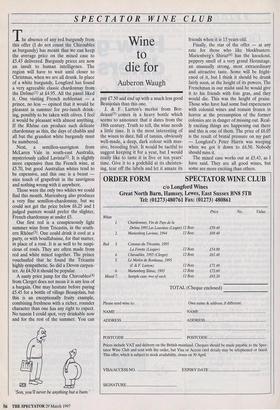SPECTATOR WINE CLUB
The absence of any red burgundy from this offer (I do not count the Chiroubles as burgundy) has meant that we can keep the average price on the mixed case to £5.43 delivered. Burgundy prices are now an insult to human intelligence. The region will have to wait until closer to Christmas, when we are all drunk. In place of a white burgundy, Longford has found a very agreeable classic chardonnay from the Drome(1) at £4.95. All the panel liked it. One visiting French nobleman — a prince, no less — opined that it would be pleasant in summer for pre-lunch drink- ing, possibly to be taken with olives. I feel it would be pleasant with almost anything. If the Rhone can produce such delicate chardonnay as this, the days of chablis and all but the grandest white burgundy must be numbered.
Next, a semillon-sauvignon from McLaren Vale in south-east Australia, mysteriously called Lavinia(2). It is slightly more expensive than the French wine, at £5.70, but good Australian whites tend to be expensive, and this one is a beaut — nice touch of grapefruit in the sauvignon and nothing wrong with it anywhere.
Those were the only two whites we could find this month. Marienberg also produces a very fine semillon-chardonnay, but we could not get the price below £6.25 and I judged punters would prefer the slighter, French chardonnay at under £5.
Our first red is a conspicuously light summer wine from Tricastin, in the south- ern Rhone(3). One could drink it cool at a party, or with bouillabaisse, for that matter, in place of a rosé. It is as well to be suspi- cious of rosés. They are often made from red and white mixed together. The prince vouchsafed that he found the Tricastin highly sympathetic. So did a Devon carpen- ter. At £4.50 it should be popular.
A nasty price jump for the Chiroubles(4) from Clerget does not mean it is any less of a bargain. One may hesitate before paying £5.45 for a bottle of village Beaujolais, but this is an exceptionally fruity example, combining freshness with a richer, rounder character than one has any right to expect. No tannin I could spot, very drinkable now and for the rest of the summer. You can 'Son, you'll never be anything but a burn.'
Wine to die for
Auberon Waugh
pay £7.50 and end up with a much less good Beaujolais than this one.
J. & F. Lurton's merlot from Bor- deaux(5) comes in a heavy bottle which seems to announce that it dates from the 18th century. Truth to tell, the wine needs a little time. It is the most interesting of the wines to date, full of tannin, obviously well-made, a deep, dark colour with mas- sive, brooding fruit. It would be tactful to suggest keeping it for a year, but I would really like to taste it in five or ten years' time. Give it to a godchild at its christen- ing, tear off the labels and let it amaze its friends when it is 15 years old.
Finally, the star of the offer — at any rate for those who like blockbusters. Marienberg's Shiraz(6) has the knockout, peppery smell of a very grand Hermitage, an unusually strong, most extraordinary and attractive taste. Some will be fright- ened of it, but I think it should be drunk fairly soon, at the height of its powers. The Frenchman in our midst said he would give it to his friends with foie gras, and they would die. This was the height of praise. Those who have had some bad experiences with colonial wines and remain frozen in horror at the presumption of the former colonies are in danger of missing out. Real- ly exciting things are happening out there and this is one of them. The price of £6.05 is the result of brutal pressure on my part — Longford's Peter Harris was weeping when we got it down to £6.50. Nobody should miss it.
The mixed case works out at £5.43, as I have said. They are all good wines, but some are more exciting than others.


































































 Previous page
Previous page